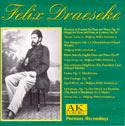Felix Draeseke: Heliotropen: Drei Gesänge (Heliotropes: Three Songs) Op. 76
Lieder:
Drei Gesänge (3 Songs) Op. 76: |
|
These songs Op. 76 are from the third part, Heliotropen (Heliotropes), from Draeseke's Op. 2 and belong to the year 1861. The composer only published them in 1906 and by comparing the piano parts in Op. 76 with the piano style of the Op. 2 Märzblumen, it is easy to imagine that Draeseke has reworked earlier versions of the Heliotropen. Once again Wolfgang Müller-Steinbach on these three songs:
The first song in Op. 76, Ich will meine Seele tauchen (I want to dip my soul) has the same text by Heinrich Heine which Robert Schumann set in his Dichterliebe, Op. 48 - have fun with the comparisons! A year before the death of Adolf Stern Draeseke was still a faithful friend and published his passionate setting of Stern´s Wie aus dürstender Blüte (Like a thirsting blossom). Ruhe in der Geliebten (Rest in the Beloved) is the second of only two poems by Ferdinand Freiligrath which Draeseke ever set – and with what majesty! |
|
| Lieder:
Drei Gesänge, Op. 76: 1.) Ich will meine Seele tauchen (Heinrich Heine) 2.) Wie aus dürstender Blüte (Adolf Stern) 3.) Ruhe in der Geliebten (Ferdinand Freiligrath) |
|
Ursprünglich sind diese Lieder, Op. 76 der dritte Teil Heliotropen in Draesekes Op. 2 und gehören in das Jahr 1861. Der Komponist ließ sie erst 1906 drucken und beim Vergleich des Klaviersatzes in Op. 76 mit dem Klavierstil in den Op. 2 Märzblumen ist es leicht anzunehmen , daß Draeseke frühere Fassungen der Heliotropen überarbeitet hatte. Nochmals Wolfgang Müller-Steinbach zu diesen drei Liedern:
Das erste Lied in Op. 76, „Ich will meine Seele tauchen“, hat genau denselben Text von Heinrich Heine, den Robert Schumann in seiner Dichterliebe, Op 48 vertont hatte: hab´ Spaß beim Vergleich! Seinem Freund Adolf Stern treu (ein Jahr vor dessen Tod) läßt Draeseke das sehnsuchtsvolle „Wie aus dürstender Blüte“ drucken. „Ruhe in der Geliebten“ ist nur das zweite Gedicht von Ferdinand Freiligrath, das Draeseke je vertont hatte - und mit Herrlichkeit! © Alan
Krueck 2003 |
|
| Draeseke's Heliotropen, op 76 on CD: | |
|
Adagio for Horn and Piano, op. 31 (1885); Romanze for Horn and Piano, op. 32 (1885); Fata Morgana, op. 13 (1877); Kleine Suite for English Horn and Piano, op. 87 (1911); Das verlassene Mägd'lein, op. 2: Vol II nr 5; Märzblumen Lieder, op. 2: Book I; Drei Gesänge, op. 76 (1906); Der Mönch von Bonifazio, melodrama after C.F.Meyer, op. 74 Wolfgang Müller-Steinbach [piano], Thomas Crome [horn], Georg Lustig [english horn], Ingrid Würtz [soprano], Helmut Loos [narrator] |
|
[Chamber Music] [Orchestral Music] [Keyboard Music] [Audio Samples] [Video] [Top]
© All contents copyright by the International Draeseke Society
